Key takeaways:
- Urban green spaces enhance mental health by reducing stress, improving mood, and fostering social connections.
- They provide vital habitats for urban wildlife, creating ecological corridors that support biodiversity.
- Community engagement in the upkeep and design of these spaces promotes a sense of pride and ownership among residents.
- Challenges in urban planning include limited space, funding constraints, and public perception of green spaces as luxuries rather than necessities.
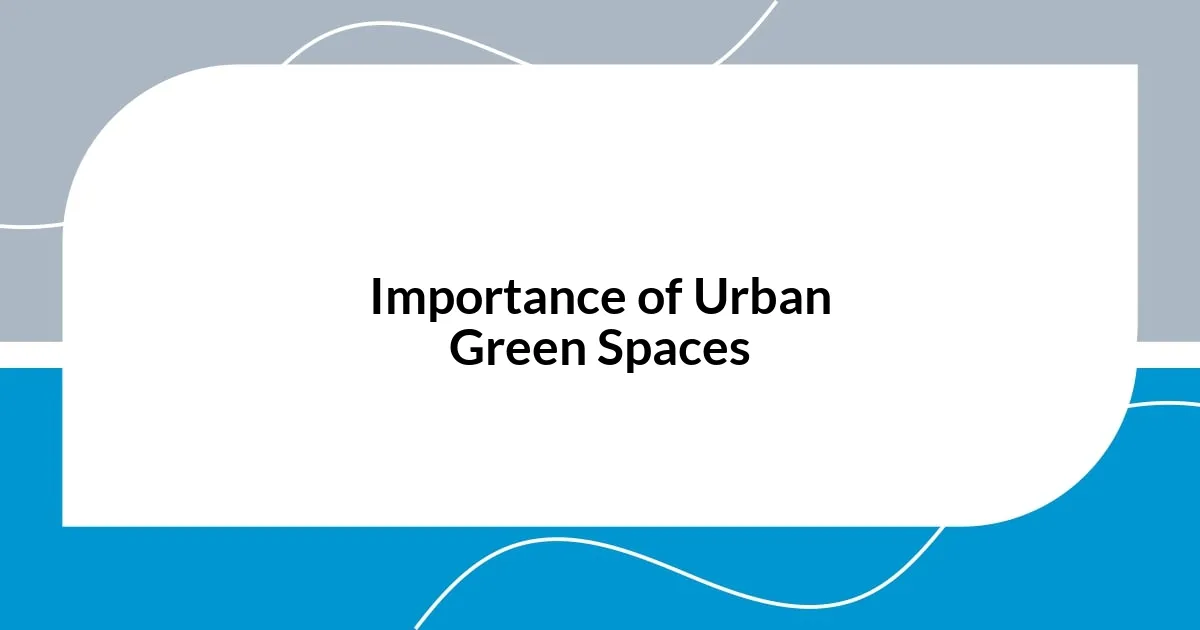
Importance of Urban Green Spaces
Urban green spaces serve as essential lungs for bustling cities, providing fresh air and crucial habitats for wildlife. I remember my first visit to a local park amidst a concrete jungle; the contrast was striking. This green oasis not only revitalized my spirit but also reminded me of nature’s role in our lives, proving that even small patches of greenery can have profound impacts on our mental health.
Beyond their aesthetic appeal, these spaces contribute significantly to community well-being. They foster social interactions, bringing diverse groups together. I often see families, joggers, and dog walkers all exchanging smiles and stories—a beautiful reminder that urban life doesn’t have to be isolating. Can you recall the last time you met someone unexpectedly in a park? The connections formed in these natural settings can lead to lasting friendships.
Furthermore, green areas play a vital role in combating climate change. They help mitigate urban heat, improve air quality, and manage stormwater. As someone who has witnessed the increasing prevalence of heatwaves, I truly appreciate the cool shade of a tree on a hot day. Isn’t it remarkable how a simple park can contribute not just to our comfort but to the planet’s health as well?
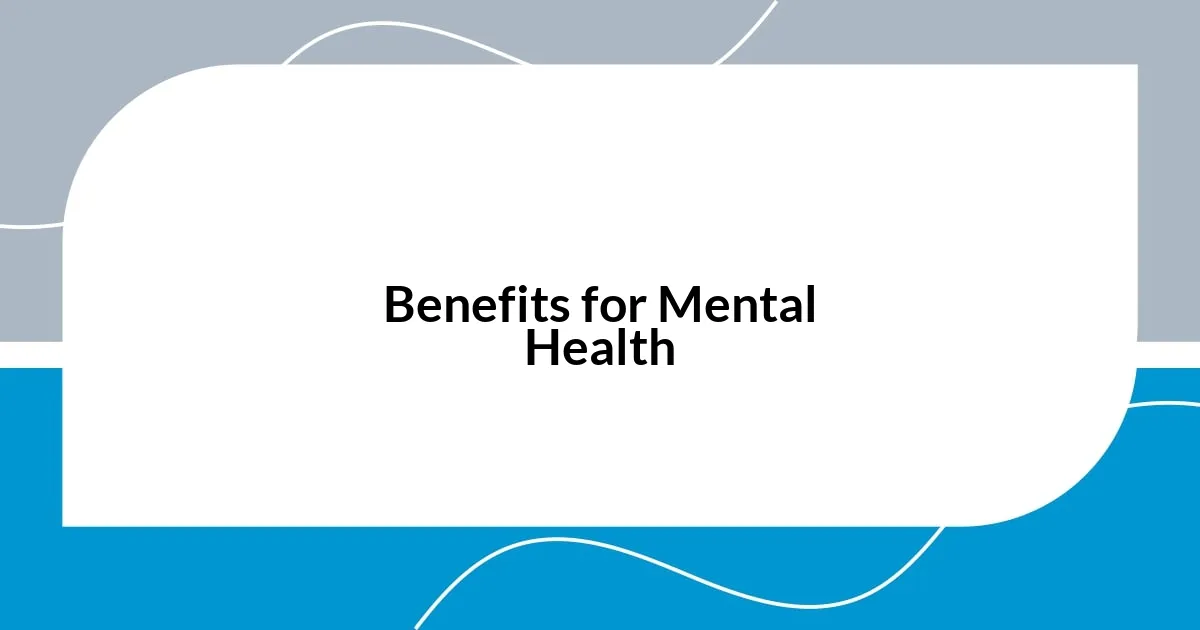
Benefits for Mental Health
Spending time in urban green spaces has a profound effect on mental health. Personally, I’ve always found that just a brief walk among flowering trees or vibrant lawns can instantly lighten my mood. There’s something refreshing about the sound of rustling leaves or chirping birds that seems to melt away the stresses of everyday life. I think we often underestimate how nature can act as a natural mood booster.
Here are some key benefits of urban green spaces for mental health:
- Stress Reduction: Nature has a calming effect, helping to lower cortisol levels, which are linked to stress.
- Improved Mood: Time spent outdoors can elevate mood and alleviate feelings of anxiety or depression.
- Enhanced Focus: Being in greenery has been shown to improve concentration and mental clarity.
- Social Connection: Parks often bring people together, reducing feelings of isolation and encouraging connection.
- Encouragement of Physical Activity: Access to green spaces promotes exercise, which is crucial for overall well-being and mental health.
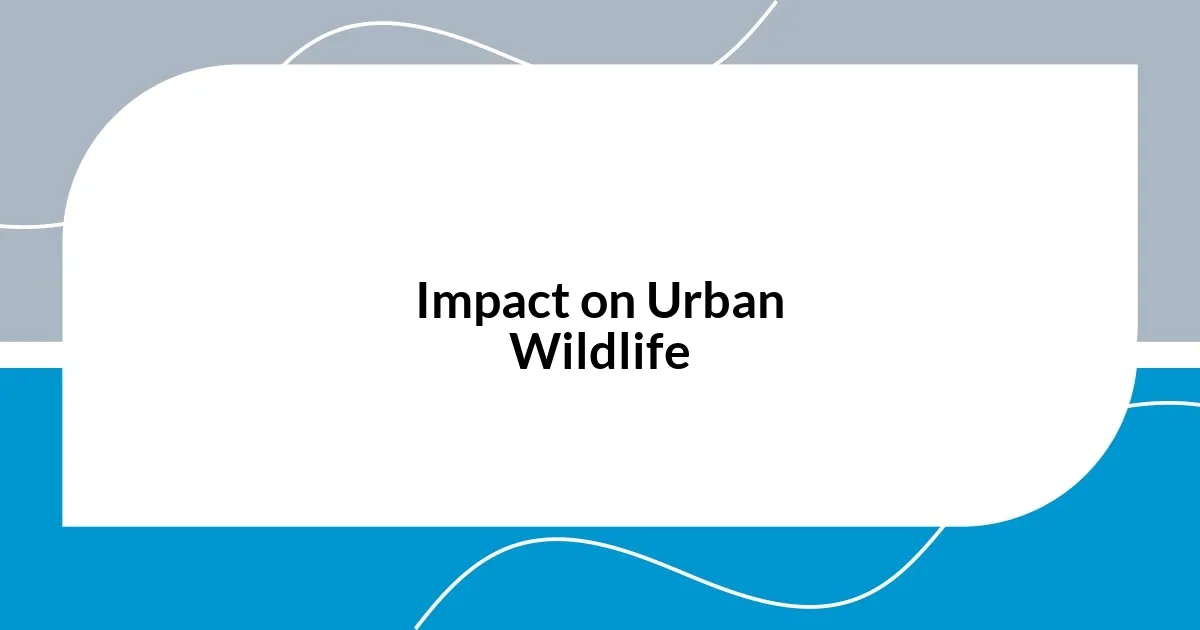
Impact on Urban Wildlife
Urban green spaces are not just beneficial for us; they also play a crucial role in supporting urban wildlife. I’ve often noticed how birds seem to flock to parks in the city, finding refuge in the trees and bushes that provide essential nesting sites. This close encounter with wildlife can be deeply moving, as it reminds us of the intricate connections we share with other living beings.
Moreover, green spaces create corridors for various species, allowing them to move more freely between habitats. A few years ago, while strolling through a local botanical garden, I was thrilled to spot a family of rabbits grazing peacefully in a secluded area. It was a beautiful moment, illustrating how even urban areas can serve as vital habitats if we prioritize and maintain our green spaces for wildlife.
Interestingly, not all urban wildlife thrives in these areas. Some species, especially those adapted to dense environments, can flourish in parks, while others may struggle. This variation highlights the importance of diverse plant life in urban landscapes. Have you ever wondered how many creatures benefit from a single tree? It’s fascinating to think that each tree could serve as a home for countless insects, birds, and small mammals, all depending on the type of greenery we cultivate.
| Urban Wildlife Benefits | Challenges |
|---|---|
| Habitat Creation | Limited Food Sources |
| Corridor for Species | Fragmentation of Habitats |
| Human-Wildlife Interactions | Increased Pollution |
| Support Biodiversity | Competition with Domestic Animals |
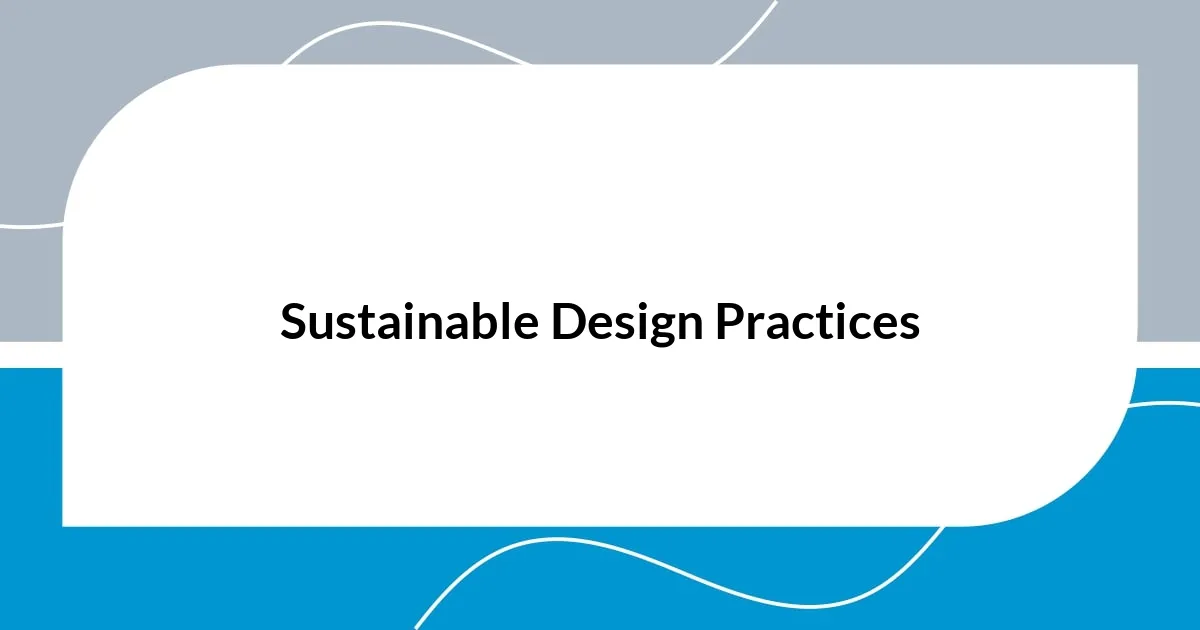
Sustainable Design Practices
Sustainable design practices are essential for creating urban green spaces that harmonize with the environment. I often think about how integrating native plants into landscaping not only supports local wildlife but also minimizes water usage. When I transformed my own backyard, choosing plants that thrived in our local climate made maintenance a breeze and created a vibrant habitat for butterflies and bees. It’s incredible how a little thought can lead to such a thriving ecosystem right in our backyards.
Incorporating green infrastructure, like rain gardens and permeable pavements, is another compelling approach to sustainable design. These features help manage stormwater runoff and reduce urban heat, making cities more resilient to climate change. I remember visiting a park with a beautifully designed rain garden, and it felt like stepping into a small oasis amidst the urban sprawl. Seeing how nature can manage water while providing beauty is a powerful reminder of our ability to work in harmony with the environment.
Furthermore, community involvement in the design process is crucial. I’ve participated in local workshops where neighbors came together to brainstorm ideas for improving our green spaces, and the energy was palpable. Have you ever experienced the joy of collaboratively creating something meaningful? It felt rewarding to witness everyone’s visions blending into a cohesive plan, reminding us that sustainable design isn’t just about environmental impact—it’s also a way to build stronger, more connected communities.
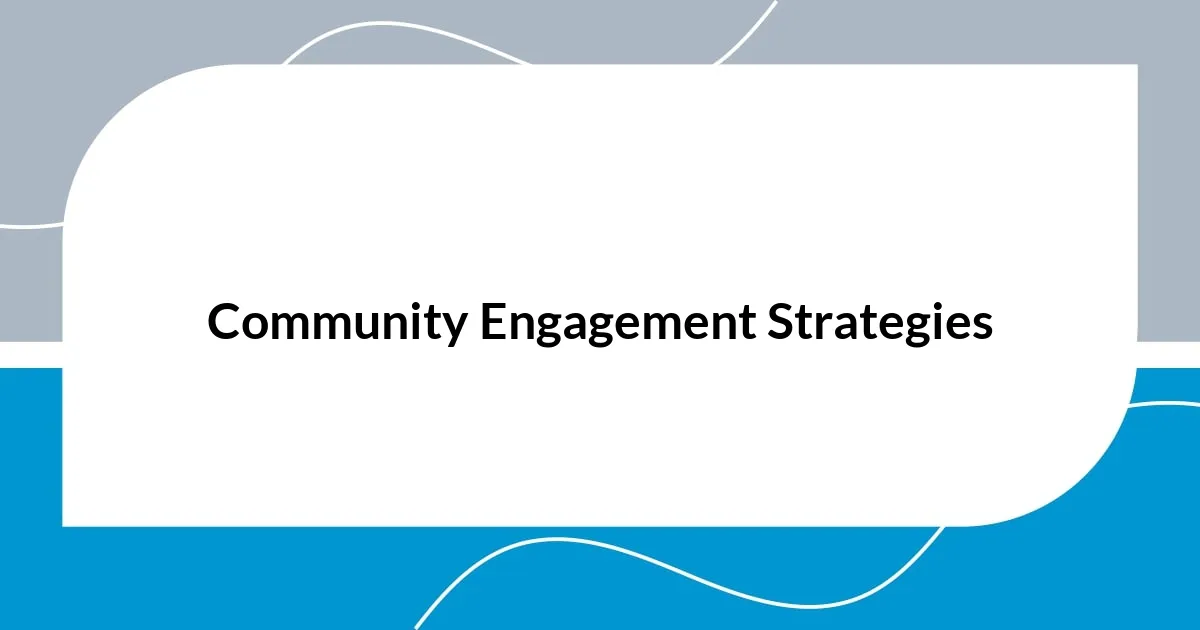
Community Engagement Strategies
Engaging the community in the development and upkeep of urban green spaces can transform these areas into thriving hubs of activity. I recall volunteering for a tree-planting event where families from the neighborhood came together to plant saplings. The excitement was contagious as children dug holes and shared stories about their favorite trees. This hands-on involvement not only deepened our connection with nature but also fostered a sense of pride in our community.
Another strategy that I’ve found effective is organizing workshops focused on environmental education. I once attended a seminar about the importance of urban gardening, and it was enlightening to learn how even small patches of land could contribute to food security. Imagine community members walking away inspired, bringing those ideas back to their homes, and encouraging kids to grow their own vegetables. By sharing knowledge, we empower individuals to take ownership of their local green spaces, creating a ripple effect of engagement.
Collaboration with local organizations can also enrich community engagement efforts. I remember a partnership between a neighborhood group and a wildlife organization that resulted in a “Wildlife Watch” program. Residents gathered data on the species they spotted in green spaces, fostering both education and a sense of stewardship. This program not only provided valuable information about the local ecosystem but also made participants feel like active guardians of their environment. Have you thought about how much stronger our communities could be by working together in such meaningful ways? It’s truly inspiring to see the impact of collective efforts.
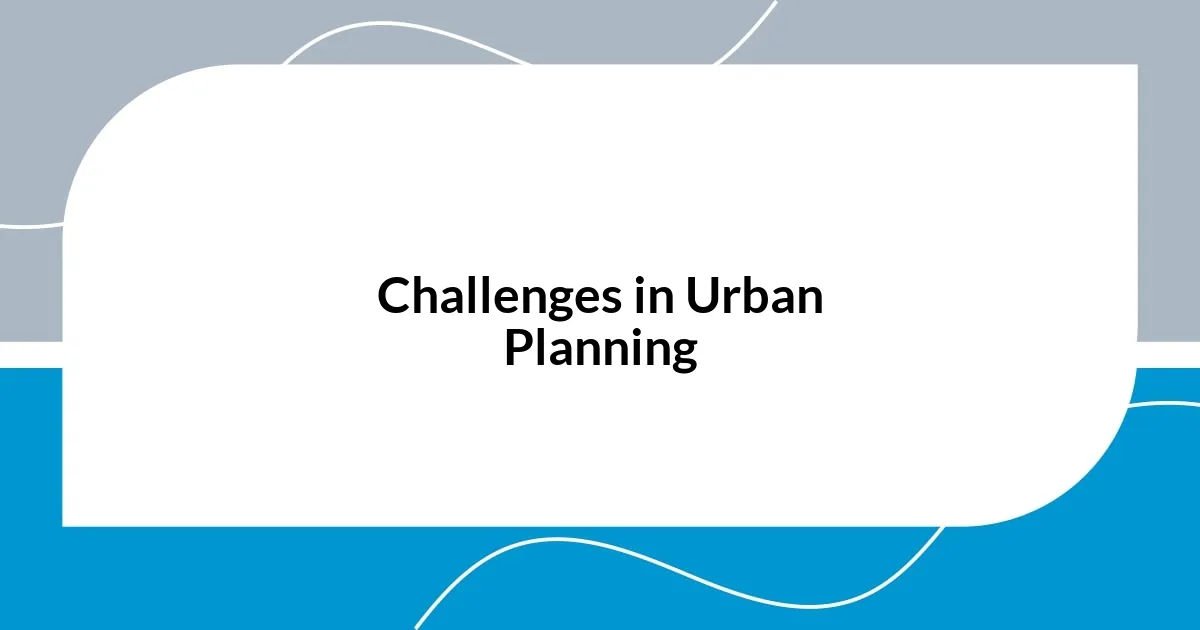
Challenges in Urban Planning
Urban planning faces several significant challenges when it comes to integrating green spaces into city life. For instance, I’ve often noticed that limited space in dense urban areas can lead to a frustrating tug-of-war between developers and environmental advocates. It can be disheartening to see land that could be transformed into a community park instead turned into another high-rise building.
Additionally, the complexities of funding and budget constraints make sustainable planning a tricky endeavor. I remember attending a city council meeting where passionate discussions unfolded over the allocation of resources. I felt a wave of frustration wash over me as it became clear that even well-intentioned green projects often languish due to a lack of financial support. It raises the question: how can we prioritize green spaces when economic pressures dominate the conversation?
Lastly, there’s the challenge of public perception and understanding of the importance of urban green spaces. I’ve had conversations with friends who view parks as mere luxury rather than essential community assets. This mindset worries me, as it undermines efforts to advocate for more green spaces. Can you imagine a city where every corner blossomed with greenery, promoting mental well-being and community connectivity? It’s apparent to me that changing perceptions is vital if we want to truly embrace the value of nature in our urban environments.
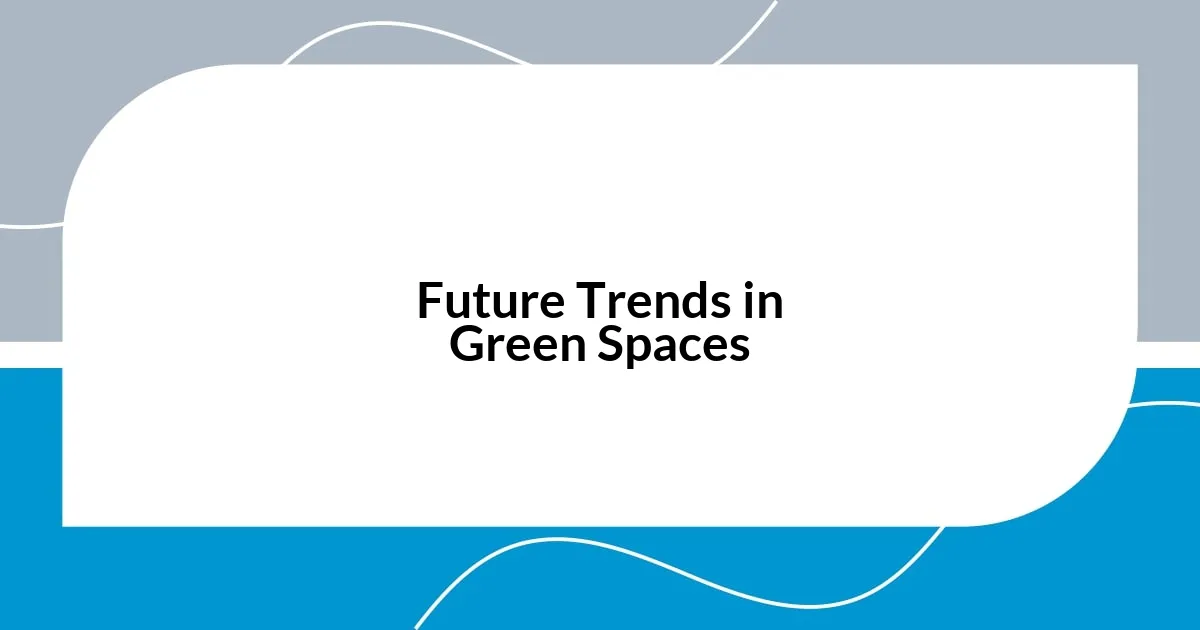
Future Trends in Green Spaces
As we look to the future, I believe there’s a strong chance we will see technology playing a critical role in developing urban green spaces. Picture smart gardens equipped with sensors that monitor soil health or weather conditions. When I came across a local initiative deploying these technologies, I was fascinated by how it empowered residents to engage with their green spaces more knowledgeably, making their efforts more fruitful.
An exciting trend I see emerging is the integration of green spaces into multi-use developments. I recently visited a new mixed-use building where terraces and rooftop gardens not only provided vegetation but also stunning views for residents. It made me think about the potential for green architecture to revolutionize our urban environments. Could these spaces be more than just amenities? Perhaps they can also foster connections among residents, transforming them into vibrant community anchors.
Finally, there’s a growing awareness of mental health benefits associated with access to nature. I’ve personally witnessed how my mood lifts during walks in local parks. This connection is prompting urban planners to prioritize mental well-being in their designs. How could improved access to greenery reshape our cities’ landscapes and enhance our quality of life? The more I ponder this, the more optimistic I feel about the future trends of green spaces translating into healthier, happier communities.